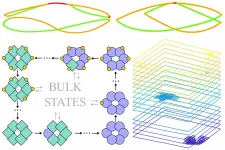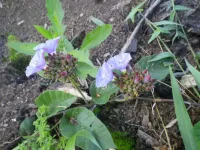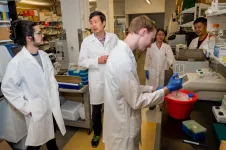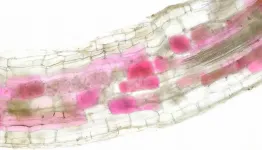Topology in biology
2021-07-23
(Press-News.org) When can we say that a certain property of a system is robust? Intuitively, robustness implies that, even under the effect of external perturbations on the system, no matter how strong or random, said property remains unchanged. In mathematics, properties of an object that are robust against deformations are called topological. For example, the letters s, S, and L can be transformed into each other by stretching or bending their shape. The same holds true for letters o, O, and D. However, it is impossible to turn an S into an O without a discontinuous operation, such as cutting the O apart or sticking the two ends of the S together. Therefore, we say that the letters s, S and L have the same topology - as do the letters o, O and D - whereas the two groups of letters have different topologies. But how does topology relate to biology?
"During the last decades, physicists have discovered that certain properties of quantum systems depend only on the topology of some underlying feature of the system, such as the phase of its wave function or its energy spectrum" explains Evelyn Tang, co-first author of the study. "We wanted to know if this model can also be applied to biochemical systems to better describe and understand processes out of equilibrium." As topology is insensitive to continuous perturbations - like the stretching or bending of letters in the example above - properties linked to topology are extremely robust. They will remain unchanged unless a qualitative change to the system occurs, such as cutting apart or sticking together the letters above. The scientists Evelyn Tang, Jaime Agudo-Canalejo and Ramin Golestanian now demonstrated that the same concept of topological protection may be found in biochemical systems, which ensures the robustness of the corresponding biochemical processes.
Flowing along the edges
One of the most famous observations regarding topology in quantum systems is the quantum Hall effect: This phenomenon occurs when a two-dimensional conducting material is subjected to a perpendicular magnetic field. In such a setting, the electrons in the material begin to move in tiny circles known as cyclotron orbits, which overall do not lead to any net current in the bulk of the material. However, at the material's edges, the electrons will bounce off before completing an orbit, and effectively move in the opposite direction, resulting in a net flow of electrons along these edges. Importantly, this edge flow will occur independently of the shape of the edges, and will persist even if the edges are strongly deformed, highlighting the topological and thus robust nature of the effect.
The researchers noticed a parallel between such cyclotron orbits in the quantum Hall effect and an observation in biochemical systems termed "futile cycles": directed reaction cycles that consume energy but are useless, at least at first sight. For example, a chemical A may get converted to B, which gets converted to C, which subsequently gets converted back to A. This raised the question: is it possible that, like for cyclotron orbits in the quantum Hall effect, futile cycles can cause edge currents resulting in a net flow in a two-dimensional biochemical reaction network?
The authors thus modelled biochemical processes that occur in a two-dimensional space. One simple example are the assembly dynamics of a biopolymer that is composed of two different subunits X and Y: A clockwise futile cycle would then correspond to adding a Y subunit, adding an X subunit, removing a Y subunit, and removing an X subunit, which would bring the system back to the initial state. Now, such a two-dimensional space will also have "edges", representing constraints in the availability of subunits. As anticipated, the researchers found that counterclockwise currents along these edges would indeed arise spontaneously. Jaime Agudo-Canalejo, co-first author of the study, explains: "In this biochemical context, edge currents correspond to large-scale cyclic oscillations in the system. In the example of a biopolymer, they would result in a cycle in which first all X subunits in the system are added to the polymer, followed by all Y subunits, then first all X and finally all Y subunits are again removed, so the cycle is completed."
The power of topology
Like in the quantum Hall system, these biochemical edge currents appear robust to changes in the shape of the system's boundaries or to disorder in the bulk of the system. Thus the researchers aimed to investigate whether topology indeed sits at the heart of this robustness. However, the tools used in quantum systems are not directly applicable to biochemical systems, which underlie classical, stochastic laws. To this end, the researchers devised a mapping between their biochemical system and an exotic class of systems known as non-Hermitian quantum systems. Evelyn Tang, who has a background in topological quantum matter, recalls: "Once this mapping was established, the whole toolbox of topological quantum systems became available to us. We could then show that, indeed, edge currents are robust thanks to topological protection. Moreover, we found that the emergence of edge currents is inextricably linked to the out-of-equilibrium nature of the futile cycles, which are driven by energy consumption."
A new realm of possibilities
The robustness arising from topological protection, coupled to the versatility inherently present in biochemical networks, results in a multitude of phenomena that can be observed in these systems. Examples include an emergent molecular clock that can reproduce some features of circadian systems, dynamical growth and shrinkage of microtubules (proteins of the cell skeleton) and spontaneous synchronization between two or more systems that are coupled through a shared pool of resources. Ramin Golestanian, co-author of the study and Director of the Department of Living Matter Physics at MPI-DS, is optimistic for the future: "Our study proposes, for the first time, minimal biochemical systems in which topologically-protected edge currents can arise. Given the wealth of biochemical networks that exists in biology, we believe it is only a matter of time until examples are found in which topological protection sensitively control the operations in such systems."
INFORMATION:
[Attachments] See images for this press release:

ELSE PRESS RELEASES FROM THIS DATE:
2021-07-23
Chemotherapy has helped make acute lymphoblastic leukemia (ALL) one of the most survivable childhood cancers. Now, researchers working in the U.S., Germany and China have shown how chemotherapy drugs called thiopurines can lead to mutations that set patients up for relapse. The work appears today in the journal Nature Cancer.
The research provides the first direct genomic and experimental evidence in pediatric cancer that drug-resistant mutations can be induced by chemotherapy and are not always present at diagnosis.
"The findings offer a paradigm shift in understanding how drug resistance develops," said Jinghui Zhang, Ph.D., Department of Computational Biology chair at St. Jude Children's Research Hospital. "The ...
2021-07-23
Rivers are lifelines for many countries. They create valuable ecosystems, provide drinking water for people and raw water for agriculture and industry. In the Global South in particular, there is strong competition for access to freshwater resources. The increasing use of hydropower has recently intensified this competition further.
Take Ethiopia, for example: when the country began filling the mega-?dam Gibe III on the Omo River in 2015, downstream users saw a drop in water volumes. Natural flooding declined, reducing the volume of fertile mud washed onto the floodplain. The level of Kenya's Lake Turkana, into which the Omo flows, fell temporarily by two metres, resulting in significant consequences for people and agriculture.
Addressing ...
2021-07-23
Scientists have identified five new plant species in the Bolivian Andes.
The species are all part of the genus Jacquemontia, which are twining or trailing plants with pretty blue flowers.
With rapid biodiversity loss taking place across South America and worldwide, identifying plant species is a vital step towards protecting them.
The new study, which classifies and describes the 28 Jacquemontia species now known to live in Bolivia and Peru, was carried out by the universities of Exeter and Oxford, and the Royal Botanic Gardens, Kew.
"Many plant species have not been identified and classified, especially in the tropics," said Rosie Clegg, of the University of Exeter and Kew.
"If you don't know what a species is, you can't ...
2021-07-23
Most children with a mental health disorder are not receiving services to address their needs--according to a new study from researchers at Simon Fraser University's Children's Health Policy Centre. Their research was published this week in the journal Evidence-Based Mental Health.
Researchers found that of the one in eight children (12.7 per cent) who experience a mental disorder, less than half (44.2 per cent) receive any services for these conditions.
"We have illuminated an invisible crisis in children's mental health and unacceptable service shortfalls in high-income countries -- including in Canada -- to a degree that violates children's rights," says study author Charlotte Waddell, ...
2021-07-23
After gaining world attention by 'unboiling' egg protein, Flinders University scientists have now used an Australian-made novel thin film microfluidic device to manipulate Beta-lactoglobulin (β-lactoglobulin), the major whey protein in cow's, sheep's and other mammals.
The so-called Vortex Fluidic Device has previously been used in an array of experiments to successfully 'un-boil' egg protein and even break the molecular bonds of one of the world's hardest material, carbon nanotubes.
In the latest application, published in Molecules, College of Science and Engineering experts have combined the capabilities of the VFD with a new form of biosensor called TPE-MI, which is an aggregation-induced emission luminogen (AIEgen).
"In the human body, protein folding is ...
2021-07-23
The human body is essentially made up of trillions of living cells. It ages as its cells age, which happens when those cells eventually stop replicating and dividing. Scientists have long known that genes influence how cells age and how long humans live, but how that works exactly remains unclear. Findings from a new study led by researchers at Washington State University have solved a small piece of that puzzle, bringing scientists one step closer to solving the mystery of aging.
A research team headed by Jiyue Zhu, a professor in the College of Pharmacy and Pharmaceutical Sciences, recently identified a DNA region known as VNTR2-1 that appears to drive the activity of the telomerase gene, which has been shown to prevent ...
2021-07-23
Almost all crop plants form associations with a particular type of fungi - called arbuscular mycorrhiza fungi - in the soil, which greatly expand their root surface area. This mutually beneficial interaction boosts the plant's ability to take up nutrients that are vital for growth.
The more nutrients plants obtain naturally, the less artificial fertilisers are needed. Understanding this natural process, as the first step towards potentially enhancing it, is an ongoing research challenge. Progress is likely to pay huge dividends for agricultural productivity.
In a study published in the journal PLOS Biology, researchers used the bright red pigments of beetroot - called betalains - to visually track soil fungi as they colonised plant roots in a living plant.
"We can now ...
2021-07-23
Many disease-causing bacteria such as Pseudomonas aeruginosa crawl on surfaces through a walk-like motility known as "twitching". Nanometers-wide filaments called type IV pili are known to power twitching, but scientists ignore which sensory signals coordinate the microbes' movements.
Now, EPFL researchers have found that Pseudomonas bacteria use a mechanism similar to our sense of touch to navigate on surfaces. "This study changes the way we think about motility in bacteria," says senior author Alexandre Persat, a tenure track assistant professor at EPFL's School of Life Sciences.
Scientists have known that ...
2021-07-23
Oncotarget published "Role for Fgr and Numb in retinoic acid-induced differentiation and G0 arrest of non-APL AML cells" which reported that retinoic acid is a fundamental regulator of cell cycle and cell differentiation.
Using a leukemic patient-derived in vitro model of a non-APL AML, these authors previously found that RA evokes activation of a macromolecular signaling complex, a signalosome, built of numerous MAPK-pathway-related signaling molecules; and this signaling enabled Retinoic-Acid-Response-Elements to regulate gene expression that results in cell differentiation/cell cycle arrest. Toward mechanistic ...
2021-07-23
Researchers from George Mason University, University of Manitoba, Colorado State University, and Georgetown University published a new paper in the Journal of Marketing that examines an unintended customer consequence of lobbying, decreased customer satisfaction, and also explains marketing-focused efforts that can help prevent it.
The study, forthcoming in the the Journal of Marketing, is titled "Shedding Light on the Dark Side of Firm Lobbying: A Customer Perspective" and is authored by Gautham Vadakkepatt, Sandeep Arora, Kelly Martin, and Neeru Paharia.
Lobbying, ...
LAST 30 PRESS RELEASES:
[Press-News.org] Topology in biology







